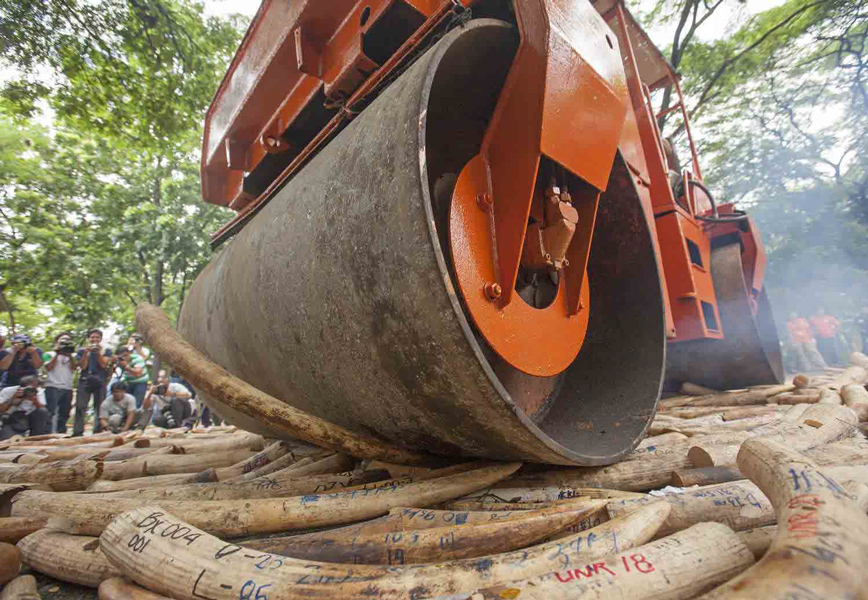Celia Ho Yen-kei seems like most teenagers. Smiling in her braces, the young anti-ivory trade activist is quick to laugh, especially when she’s showing pictures of her pet parrots. But her exceptional character quickly surfaces during the interview, when she explains why she had to postpone a previous meeting: a threatening letter filled with some white powder was sent to her at school just over a week ago.
There was no message attached, just a large “X” marked on paper, so her teachers called in the police. “I think it was someone from the illegal ivory trade, or someone who is jealous of the attention my campaign is getting,” Celia explains.
Yet the 14-year-old isn’t intimidated and does not hesitate when asked if she will continue her campaign to ban ivory. “Of course!” she says. “My parents were worried, but they said I could keep doing the campaign.”
Celia first learned about what she calls “the bloody ivory trade” from National Geographic magazine. “I saw a picture of an elephant killed by a poacher with blood on his tusks. It was a shock, because the demand is coming from China, and I’m Chinese. I wanted to help.”
There were 1.3 million elephants in Africa in the 1970s; today the population has shrunk to between 400,000 and 500,000, conservationists say. In recent years, about 40,000 African elephants have been slaughtered for their tusks annually, says Joyce Poole, a zoologist and co-director of the conservation group ElephantVoices.
“I’m losing sleep over this,” says Poole, who has spent her life studying elephants. “It is very disturbing. The kind of suffering that it’s causing these animals is just unbelievable.
“Thousands are being killed, and many of them are being injured and suffering for days, weeks and months before they die. For every adult female who is killed, an orphan is left to die. Families are being destroyed.”
Prospects for the pachyderm haven’t always looked so grim. Conservationists secured a big victory in 1989 when the African elephant was included on appendix one of the Convention on International Trade in Endangered Species of Wild Fauna and Flora (Cites). That effectively banned the international ivory trade.
Although Cites officials approved a one-off sale of 50 tonnes of confiscated African ivory to Japan a year later, the ban, coupled with awareness campaigns, helped revive populations.
But their authorisation of a second controversial sale of 107 tonnes of stockpiled African ivory in 2008 to Japan and China, where ivory carving has a long history, ignited a poaching crisis.
“After the sale in 2008, poaching skyrocketed,” says Grace Ge Gabriel, Asia regional director for the International Fund for Animal Welfare (IFAW).
The influx of legal ivory not only created unprecedented demand, but provided convenient cover for poached ivory to enter the increasingly prosperous mainland. To secure Cites approval for ivory purchase, Chinese officials set up a system to register all ivory carving factories and retail outlets. But violations are rampant, Gabriel says.
A 2011 probe into Chinese ivory markets by IFAW officials found that 101 out of 158 factories and stores they visited did not have a licence. Of the 57 licensed enterprises, many sold ivory without the required ID cards.
Because it is the largest market for illegal ivory – experts estimate that 40 per cent of poached ivory is destined for the mainland – China has effectively become the economic engine driving the slaughter of African elephants.
“What we have now is a combination of new money in China and more Chinese in Africa getting into the business on the African end,” says Peter Knights, executive director of WildAid, which has also campaigned against eating shark’s fin.
“We’re going through the same issues we went through before, like excessive consumer demand, but with different players. New emerging economies come with their own demands. You need aggressive education campaigns coupled with stronger laws.”
IFAW’s campaign last year has shown how an engaging public education programme can shift consumer attitudes. The group conducted a survey in 2007 which showed seven out of 10 respondents didn’t realise elephants had to be killed for ivory.
Building on this information, IFAW launched a widespread education campaign on the mainland this year. It featured a baby elephant with his mother, and made the message crystal clear: the calf proudly shows off his new teeth, but his mother is anxious because she knows the tusks make her baby a target.
It proved remarkably effective. An evaluation of the campaign in April showed that 75 per cent of China’s urban population had seen the image, and this reduced the number of people likely to buy ivory by 28 per cent. About 90 per cent of respondents said they would not buy ivory if an elephant had to die for it.
Knights hopes WildAid can help drive home the message and stop the purchase of ivory products. WildAid had unprecedented success at reducing demand for shark’s fin on the mainland though print adverts, commercials and collaborations with former NBA player Yao Ming. It has also run anti-tiger poaching campaigns with Jackie Chan.
Now he hopes they can do the same for ivory with actress Li Bingbing. “There is already a broad awareness of these issues and a broad public sympathy,” Knights says.
But changing attitudes in the central government is likely to be far harder. On a recent speaking tour of the mainland, Poole was struck by the contrast between the public’s opinion and the government’s.
Recalling a lecture to a crowd of about 300 people, she says, “They [the crowd] asked excellent questions and showed concern about animal welfare in the country. That audience ranged from little kids to university students, members of the press, professors and teachers. It gave me a lot of hope.”
But officials were far less receptive: “They didn’t want to hear about it. They said China is not at fault, that China did not buy illegal ivory, that there were very good systems in place to prevent illegal ivory from coming in despite documents by Cites showing that 40 per cent of the illegal movement of ivory is destined for China,” Poole says.
The facts and figures speak for themselves, Poole says. “China represents the largest single market for the illegal trade; it is a market that is increasing in size.”
Much of that illegal ivory is getting to the mainland via Hong Kong. This is the major port of entry for tusks, even though local demand has shrunk considerably since the 1980s.
Last year alone, customs officials seized 5,290 kilograms of ivory in 35 operations at container terminals and the airport, according to the Agriculture, Fisheries, and Conservation Department.
That amount of ivory alone represents the slaughter of about 530 elephants, and experts estimate customs seizures make up just 10 per cent of all the tusks smuggled.
The department refuses to reveal the size of its ivory stockpile, citing security concerns, though it must be considerable. Under Cites, confiscated ivory must be destroyed – “put beyond all use” – or used for educational purposes. The department raised the possibility of incinerating its stockpile at an Endangered Species Advisory Committee meeting in August 2012. But the panel decided that burning the ivory would be wasteful and potentially damaging to the environment; the tusks should be used as an educational tool.
Activists and conservation groups disagree. They argue that destroying the amassed tusks would make a strong statement. A public crushing of five tonnes of confiscated ivory in the Philippines last month has increased pressure on the Hong Kong government to do the same.
Destroying the stockpile, Poole says, “sends a strong message: Don’t. Buy. Ivory. Publicly destroy the ivory stockpile and say, ‘This is contraband. Ivory should not be bought, used, or sold.’”
Gabriele agrees: “Destroying the stockpile is important. It represents Hong Kong’s determination to fight this trade.”
Alex Hofford, a Hong Kong- based photojournalist specialising in environmental issues, and a vocal opponent of the ivory trade, has been trying to form a group to save the elephants. Members of the group are trying to get Hong Kong involved in the International March for Elephants, a series of events taking place around the world on October 4. Celia hopes the government is serious about using the ivory as an education tool: “I hope the government can set up a long-term educational exhibition exposing the bloody ivory trade. Ocean Park would be ideal because of its many visitors. And they already have a conservation foundation.”
Meanwhile, she is trying to spread the word with a video she has produced about elephant poaching; the idea is to screen it in schools in Hong Kong and on the mainland.
But, asked if people in Hong Kong care about stopping the ivory trade, she shakes her head. “Not really. We’ve got to raise awareness,” she laments.



